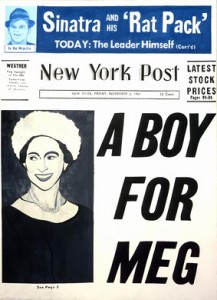 If he hadn’t turned the art world on its head, Andy Warhol would have been pretty good in newspaper layout. He had a clear appreciation for the bold italics of a well chosen banner, liked the style of a standalone photograph and caption and the overall bold impact of a tabloid page one.
If he hadn’t turned the art world on its head, Andy Warhol would have been pretty good in newspaper layout. He had a clear appreciation for the bold italics of a well chosen banner, liked the style of a standalone photograph and caption and the overall bold impact of a tabloid page one.
In the new exhibit “Warhol Headlines” at the National Gallery of Art, it’s clear that he began copying whole front pages in longhand when he was back in Kentucky, adding his own details or hanging names as it amused him.
By the time he was in New York in the late 50s, he was saving and copying front pages that captivated him. Usually they had to do with royalty whether in pop culture, with the drama of Eddie Fisher, Liz Taylor and Debbie Reynolds or in actually royalty, as when his “A BOY FOR MEG” announced the birth of a son to Princess Margaret of England (while also hyping a feature on Sinatra and his rat pack).
Warhol liked the big stories and he liked the ephemera of the surrounding circus. It was a microcosm of his own career, fascinated by the surrounding media, but also a part of it.
Using an opaque projector to carefully replicate front pages, he included every odd detail, including in 129 DIE IN JET even the smear of ink between letters I and N.
 The National Gallery show jumps around a bit, pretty much adding every portrait it could find with people holding a tabloid paper or otherwise reflecting it somehow. But he did some interesting things actually working for the Daily News, with a campaign for delivery trucks that combined big headline front pages with a spray of day-glo flowers. It never got to the side of the trucks but it made for some zippy designs.
The National Gallery show jumps around a bit, pretty much adding every portrait it could find with people holding a tabloid paper or otherwise reflecting it somehow. But he did some interesting things actually working for the Daily News, with a campaign for delivery trucks that combined big headline front pages with a spray of day-glo flowers. It never got to the side of the trucks but it made for some zippy designs.
A couple of the biggest surprises in the show are his big collaborations with Jean-Michele Basqiat and Keith Haring – variations on a theme where they each riffed the way they knew best.
The exhibit pairs the works when it can with the original inspirations. By and large he stays true to the pages, but he takes some flights as well. Warhol saved stacks of these papers just in case he wanted to return to them as subjects.
He made his own paper, of course, an underground paper with a brief run that has the name Plastic Exploding Inevitable, same name of the music and film festival he also created.
(But there’s no example of Interview, the magazine he started that still continues in its big blossy stylish way).
 Warhol himself ended up as a tabloid headline as well, the reproduction of which was left to the museum: ANDY WARHOL DEAD AT 58.
Warhol himself ended up as a tabloid headline as well, the reproduction of which was left to the museum: ANDY WARHOL DEAD AT 58.
“Warhol Headlines” continues at the National Gallery of Art in Washington, D.C., through